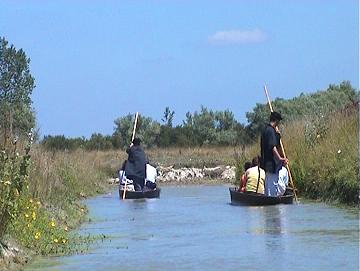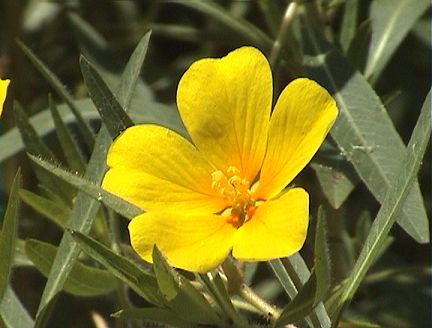
Waterteunisbloem / Jussie / Water Primrose
Ludwigia uruguayensis (syn. Jussiaea uruguayensis) (Onagraceae)

Met "jussie"-planten dichtgegroeide sloot in de Franse Vendée.






 Deze plant is een verwant van onze teunisbloem, die evenals deze ook oorspronkelijk van het
westelijk halfrond afkomstig schijnt te zijn, maar al zo "ingeburgerd" dat men zich dat
bijna niet meer kan voorstellen. Deze waterplant is echter niet viertallig zoals de teunisbloem
en verscheidene andere Onagraceae zoals wilgeroosjes en fuchsia's, maar 5-tallig.
Deze plant is een verwant van onze teunisbloem, die evenals deze ook oorspronkelijk van het
westelijk halfrond afkomstig schijnt te zijn, maar al zo "ingeburgerd" dat men zich dat
bijna niet meer kan voorstellen. Deze waterplant is echter niet viertallig zoals de teunisbloem
en verscheidene andere Onagraceae zoals wilgeroosjes en fuchsia's, maar 5-tallig.
Hoewel het boottochtje over het Franse Canal du Perrier veel minder voorstelde dan de folder deed
voorkomen, leverde het mij de aanblik + mooie foto's op van dit in warmere streken
hardnekkige wateronkruid dat eigenlijk beter tot zijn oorspronkelijke Zuid-Amerikaanse biotoop
beperkt had kunnen blijven, omdat het vervelende eigenschappen vertoont (o.a. in Frankrijk meer naar het zuiden, en
in de V.S. in o.a. Texas en Louisiana) die doen denken aan die van de
waterhyacint, zoals het verstikken en onbevaarbaar maken van waterwegen.
Dit is een plant waarvan ik geen officiële Nederlandse naam weet, maar wel de Franse ("jussie"), omdat hij bij
ons het klimaat te koud vindt om goed te gedijen, hoewel hij enige vorst wel schijnt te overleven.
De plant wordt wel gebruikt voor aquaria, en is als zodanig ook zijn verspreiding over de wereld
begonnen - de mooie en talrijke gele bloemen waren een verleiding om hem mee te nemen voor tuinvijvers en aquaria.
 De lange spitse "wilg-achtige" bladeren zijn enigszins behaard, en op de foto hiernaast zijn zowel de nog
neerhangende knoppen te zien als een uitgevallen bloem. Rechts een knop, die zich juist opricht om te gaan
bloeien.
De lange spitse "wilg-achtige" bladeren zijn enigszins behaard, en op de foto hiernaast zijn zowel de nog
neerhangende knoppen te zien als een uitgevallen bloem. Rechts een knop, die zich juist opricht om te gaan
bloeien.
De vruchten zijn harde droge zaaddozen, die nauwelijks open schijnen te gaan. Maar vegetatieve
vermeerdering is bij deze plant ook heel populair, hij komt er wel. Afgebroken stukken stengel en wortelstokken
lopen zelfstandig weer uit in het water en vormen nieuwe planten.
Ongetwijfeld is de plant genoemd naar de drie Franse
gebroeders en botanici Jussieu uit de 17de en 18de eeuw, of naar hun neef Antoine-Laurent (*1748), die een systeem
ontwikkelde om het plantenrijk in te delen.








 This Water Primrose is related to Evening Primrose, which just like this one originates from the western hemisphere,
but nowadays is so "common" that hardly anybody can imagine it's not indigenous.
This Water Primrose is related to Evening Primrose, which just like this one originates from the western hemisphere,
but nowadays is so "common" that hardly anybody can imagine it's not indigenous.
The waterplant, however, is not quaternary like evening primrose and various other Onagraceae like
fireweed and fuchsia, but quinary.
Although the boattrip on the French Canal du Perrier wasn't really worthwhile, it offered me the opportunity
to watch this fuchsia-related plant and take pictures of it. This charming beauty, however, has very unpleasant qualities
growing in warmer regions, it's a noxious waterweed blocking canals and suffocating other living creatures in the water,
a.o. in more southern parts of France and in the USA, e.g. Texas and Louisiana. It reminds us of waterhyacint
in that respect. It should have stayed in its original South American environment only, but people fell in love with its abundance of
fine yellow flowers, so decorative in their aquaria and ponds.
With us in the Netherlands, the plant doesn't even have a name, because it can't survive in our climate, though it seems to be able to
stand some frost. In French it's called "jussie", I heard from the boat-boy who poled us around.
 The lanceolate "willowish" leaves are a bit hairy, and in the picture on the left you can see the flowerbuds still hanging
down, and a flower just having lost its petals. On the right, a bud sticking up its head to open up.
The lanceolate "willowish" leaves are a bit hairy, and in the picture on the left you can see the flowerbuds still hanging
down, and a flower just having lost its petals. On the right, a bud sticking up its head to open up.
The fruits, according
to what I read somewhere, must be dry and extremely hard and hardly opening to release any seeds, but vegetative reproduction
seems favourite with this plant, it will do. Broken-off bits of stems and rhizomes start growing again themselves and rapidly
form new plants.
Undoubtedly the plant was named after the Jussieu-brothers, three French botanists born in the 17th and
18th centuries, or their nephew Antoine-Laurent (*1748), who developed a classification system to determinate plants.



